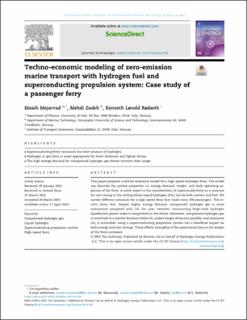| dc.contributor.author | Mojarrad, Masih | |
| dc.contributor.author | Zadeh, Mehdi | |
| dc.contributor.author | Rødseth, Kenneth Løvold | |
| dc.date.accessioned | 2024-02-23T08:40:34Z | |
| dc.date.available | 2024-02-23T08:40:34Z | |
| dc.date.created | 2023-04-28T11:42:36Z | |
| dc.date.issued | 2023-07-28 | |
| dc.identifier.citation | International Journal of Hydrogen Energy. 2023, 48 (71), 27427-27440. | en_US |
| dc.identifier.issn | 0360-3199 | |
| dc.identifier.uri | https://hdl.handle.net/11250/3119522 | |
| dc.description | Masih Mojarrad, Mehdi Zadeh, Kenneth Løvold Rødseth, Techno-economic modeling of zero-emission marine transport with hydrogen fuel and superconducting propulsion system: Case study of a passenger ferry, International Journal of Hydrogen Energy, Volume 48, Issue 71, 2023, Pages 27427-27440, ISSN 0360-3199, https://doi.org/10.1016/j.ijhydene.2023.03.438. | en_US |
| dc.description.abstract | This paper proposes a techno-economic model for a high-speed hydrogen ferry. The model can describe the system properties i.e. energy demand, weight, and daily operating expenses of the ferry. A novel aspect is the consideration of superconductivity as a measure for cost saving in the setting where liquid hydrogen (LH2) can be both coolant and fuel. We survey different scenarios for a high-speed ferry that could carry 300 passengers. The results show that, despite higher energy demand, compressed hydrogen gas is more economical compared with LH2 for now; however, constructing large-scale hydrogen liquefaction plants make it competitive in the future. Moreover, compressed hydrogen gas is restricted to a shorter distance while LH2 makes longer distances possible, and whenever LH2 is accessible, using a superconducting propulsion system has a beneficial impact on both energy and cost savings. These effects strengthen if the operational time or the weight of the ferry increases. | en_US |
| dc.description.abstract | Techno-economic modeling of zero-emission marine transport with hydrogen fuel and superconducting propulsion system: Case study of a passenger ferry | en_US |
| dc.language.iso | eng | en_US |
| dc.publisher | Elsevier Ltd on behalf of Hydrogen Energy Publications LLC | en_US |
| dc.rights | Navngivelse 4.0 Internasjonal | * |
| dc.rights.uri | http://creativecommons.org/licenses/by/4.0/deed.no | * |
| dc.subject | Compressed hydrogen gas | en_US |
| dc.subject | Liquid hydrogen | en_US |
| dc.subject | Superconducting propulsion system | en_US |
| dc.subject | High-speed ferry | en_US |
| dc.title | Techno-economic modeling of zero-emission marine transport with hydrogen fuel and superconducting propulsion system: Case study of a passenger ferry | en_US |
| dc.title.alternative | Techno-economic modeling of zero-emission marine transport with hydrogen fuel and superconducting propulsion system: Case study of a passenger ferry | en_US |
| dc.type | Journal article | en_US |
| dc.type | Peer reviewed | en_US |
| dc.rights.holder | © 2023 The Author(s). | en_US |
| dc.description.version | publishedVersion | en_US |
| cristin.ispublished | true | |
| cristin.fulltext | original | |
| cristin.qualitycode | 1 | |
| dc.identifier.doi | 10.1016/j.ijhydene.2023.03.438 | |
| dc.identifier.cristin | 2144164 | |
| dc.source.journal | International Journal of Hydrogen Energy | en_US |
| dc.source.volume | 48 | en_US |
| dc.source.issue | 71 | en_US |
| dc.source.pagenumber | 27427-27440 | en_US |

